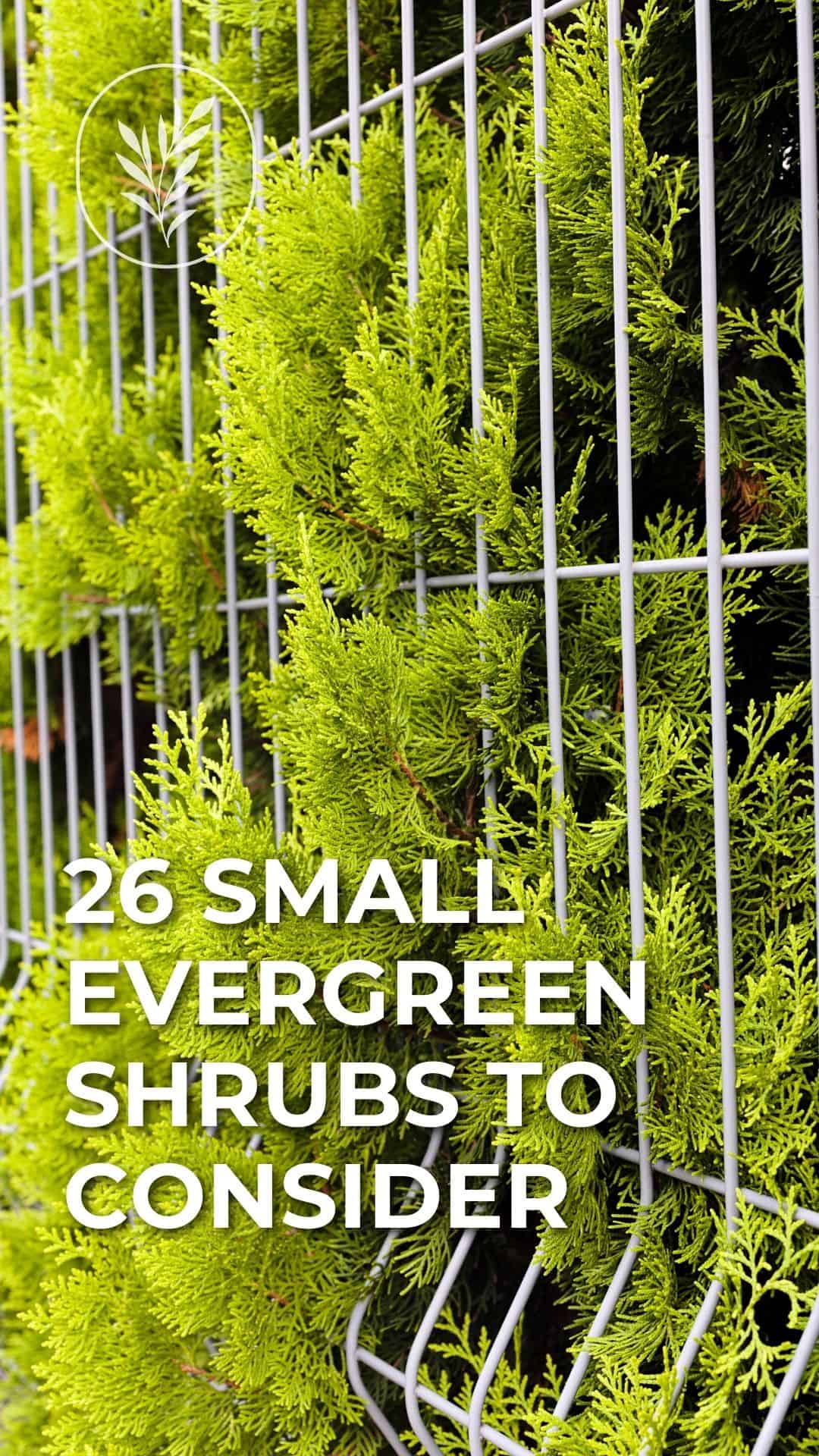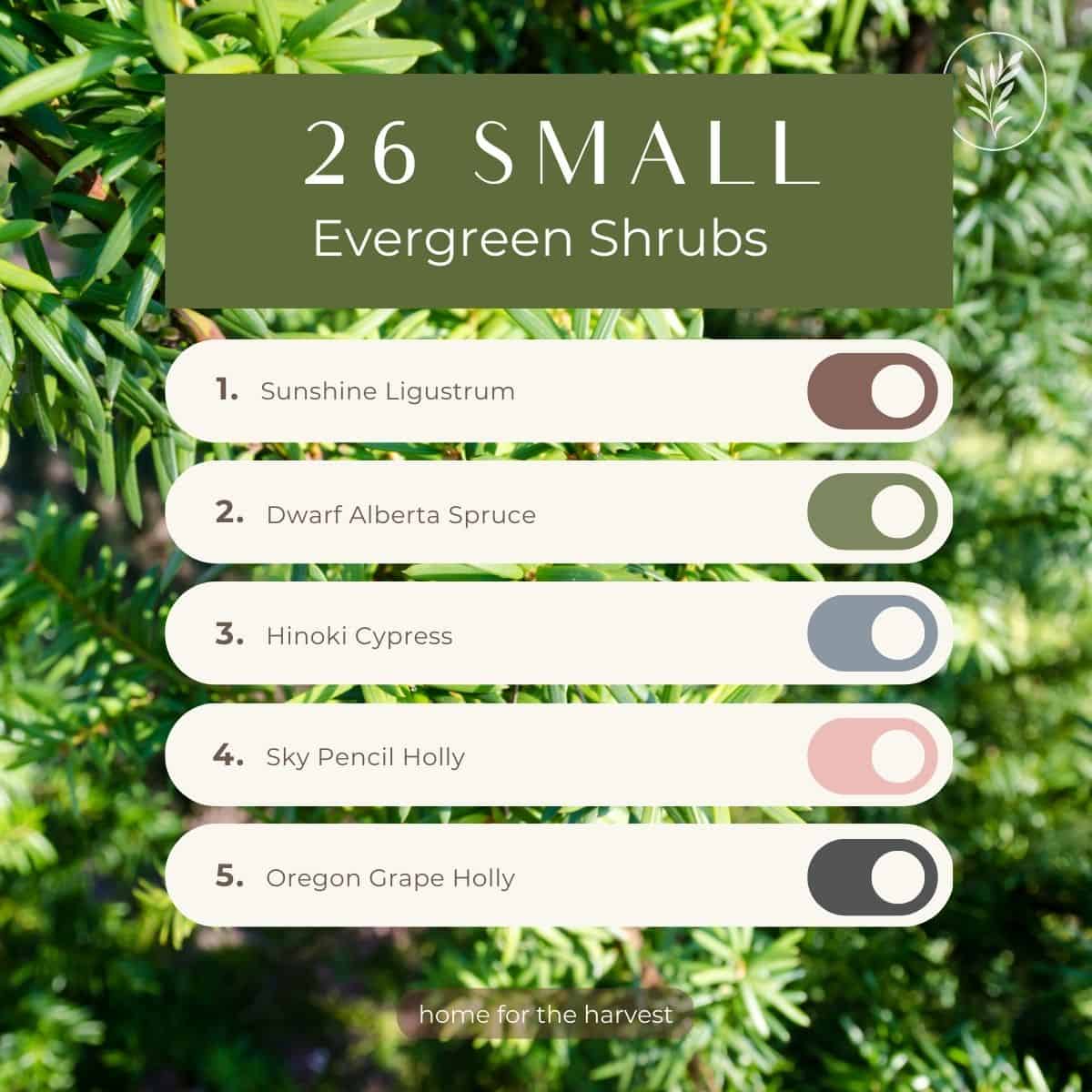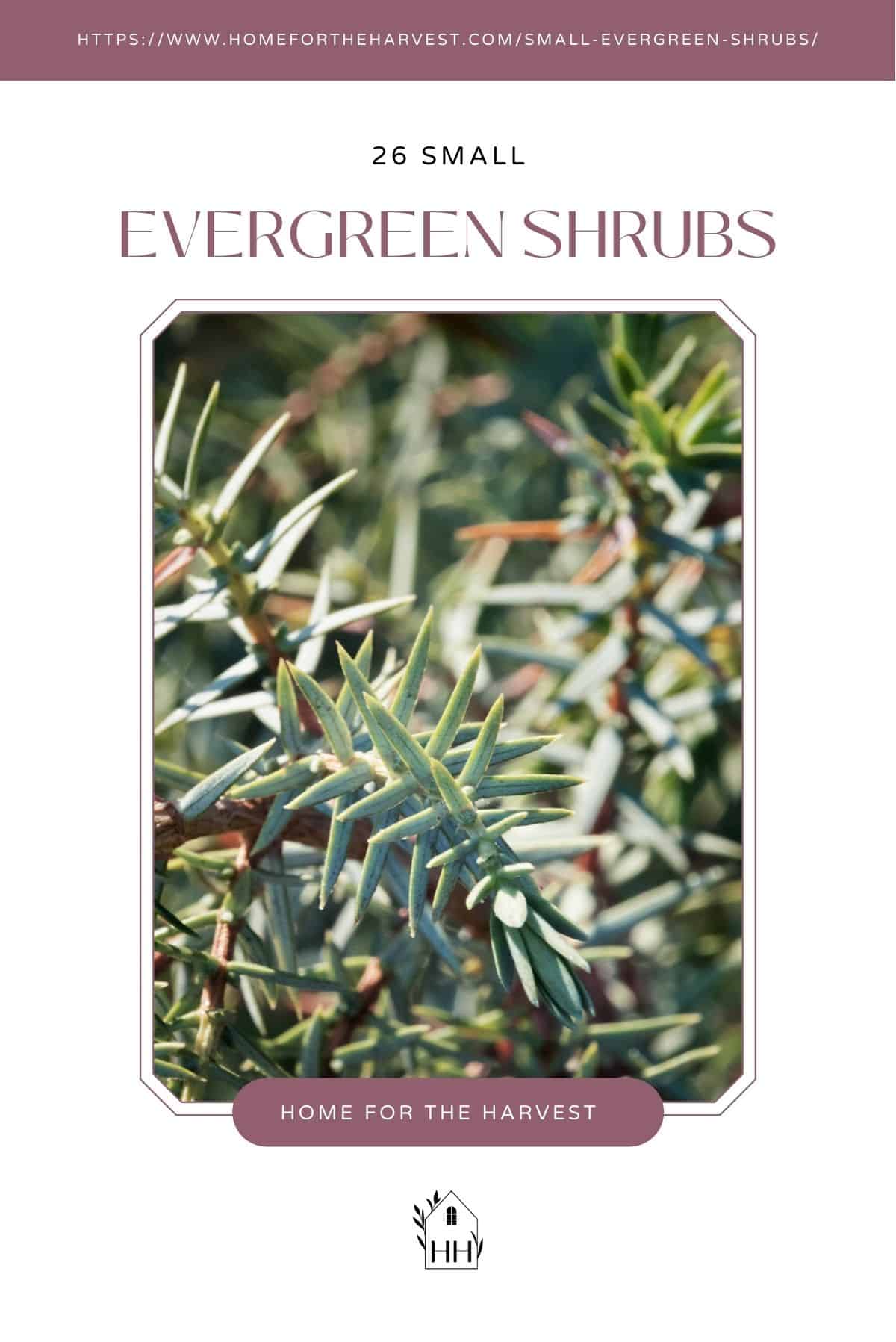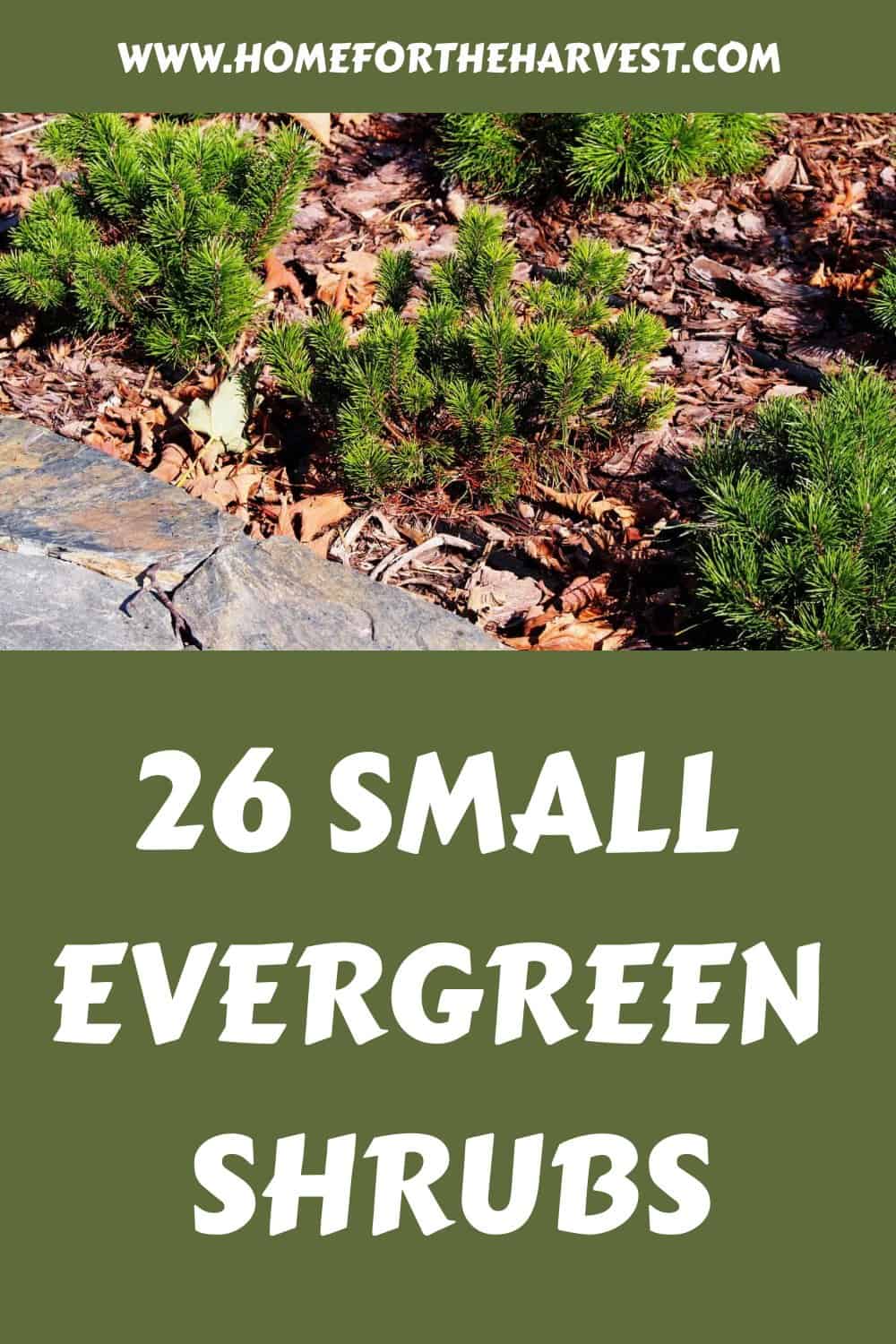Small evergreen shrubs are perfect for accenting gardens and walkways. They provide year-round green color, require little maintenance, and are generally low-growing plants. Here are some of the most popular small evergreen shrubs to consider planting.
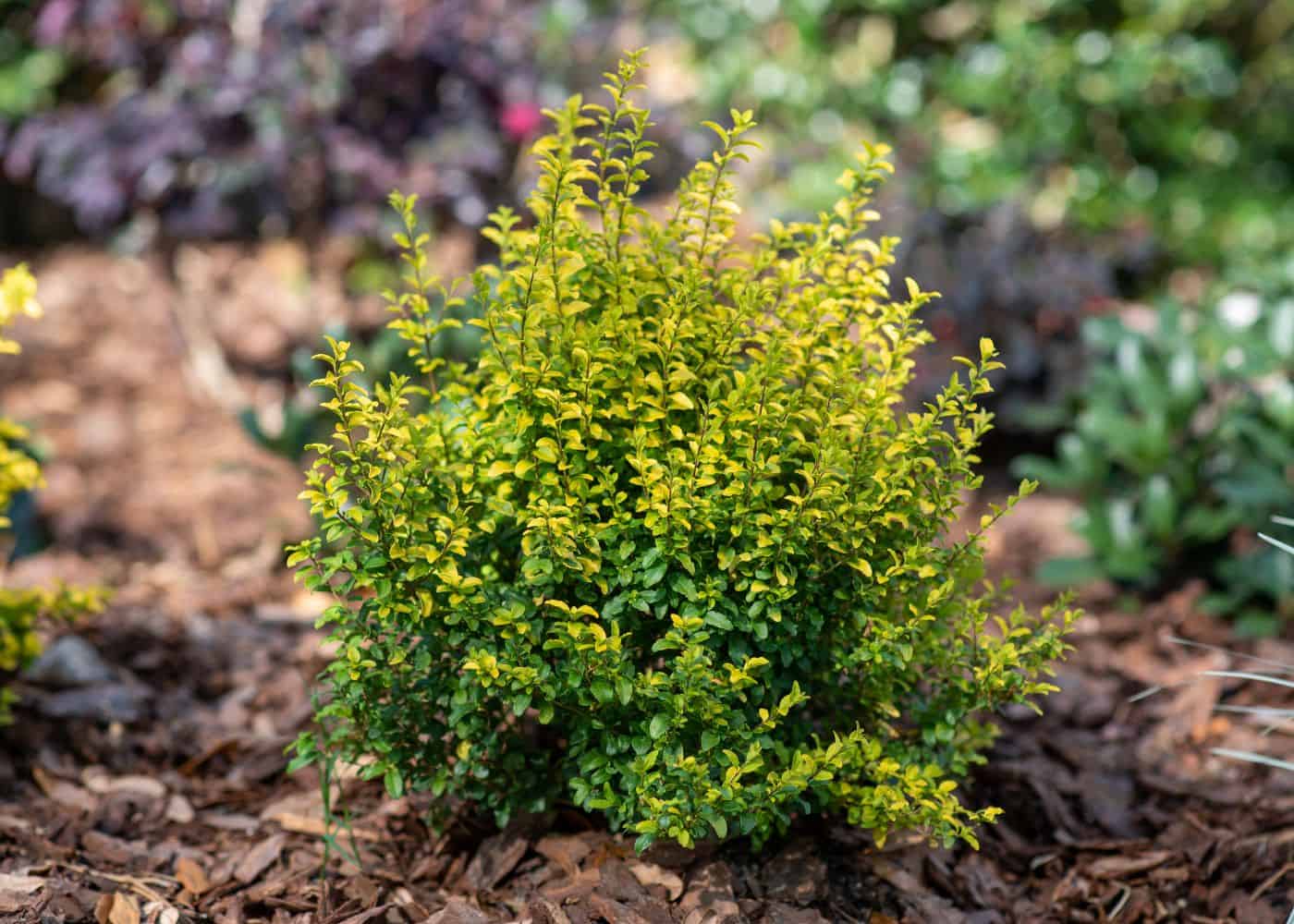
1. Sunshine ligustrum
Sunshine ligustrum (Ligustrum sinense ‘Sunshine’) is a small broadleaf evergreen shrub known for its bright golden-green foliage. A variety of Privet, this fast-growing little plant grows to a mature size of about 3-4 feet tall and 3-4 feet wide. Ligustrum shrubs can be planted alone as a single specimen, together as a grouping of specimens, or in a line as a low border along a walkway.
Sunshine Ligustrum is resistant to many common pests and diseases and also resistant to many harsh environmental conditions. It is resistant to deer, pest insects, and mildew fungal diseases. Ligustrum is typically both drought and heat tolerant once established.
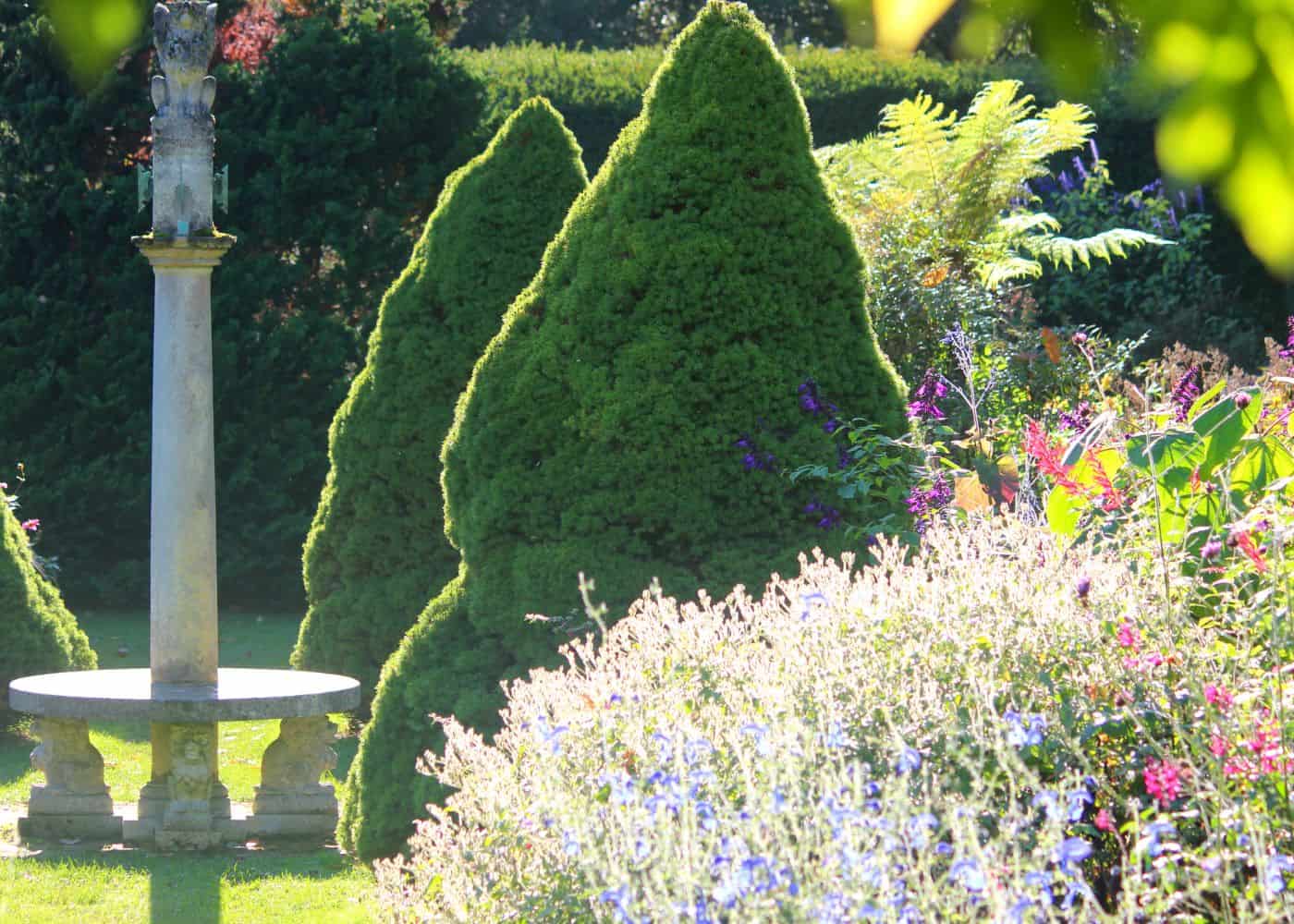
2. Dwarf Alberta spruce
Dwarf Alberta spruce (Picea glauca ‘Conica’) is a dwarf evergreen tree that works well in the landscape as a compact cone-shaped shrub. These plants grow to a mature size of 5-8 feet tall and 3-4 feet wide.
Dwarf Alberta spruces are usually planted as single specimens or accent trees that structure the landscape year-round. They’re also good for low-maintenance landscapes, as they grow naturally into a neat triangular shape and do not need pruning.
Alberta spruce is deer-resistant and can provide habitat to birds and other beneficial creatures. These miniature trees also tolerate container planting (as long as they are planted in a large exterior planter pot). You can even dress them up as tiny Christmas trees in your landscape!
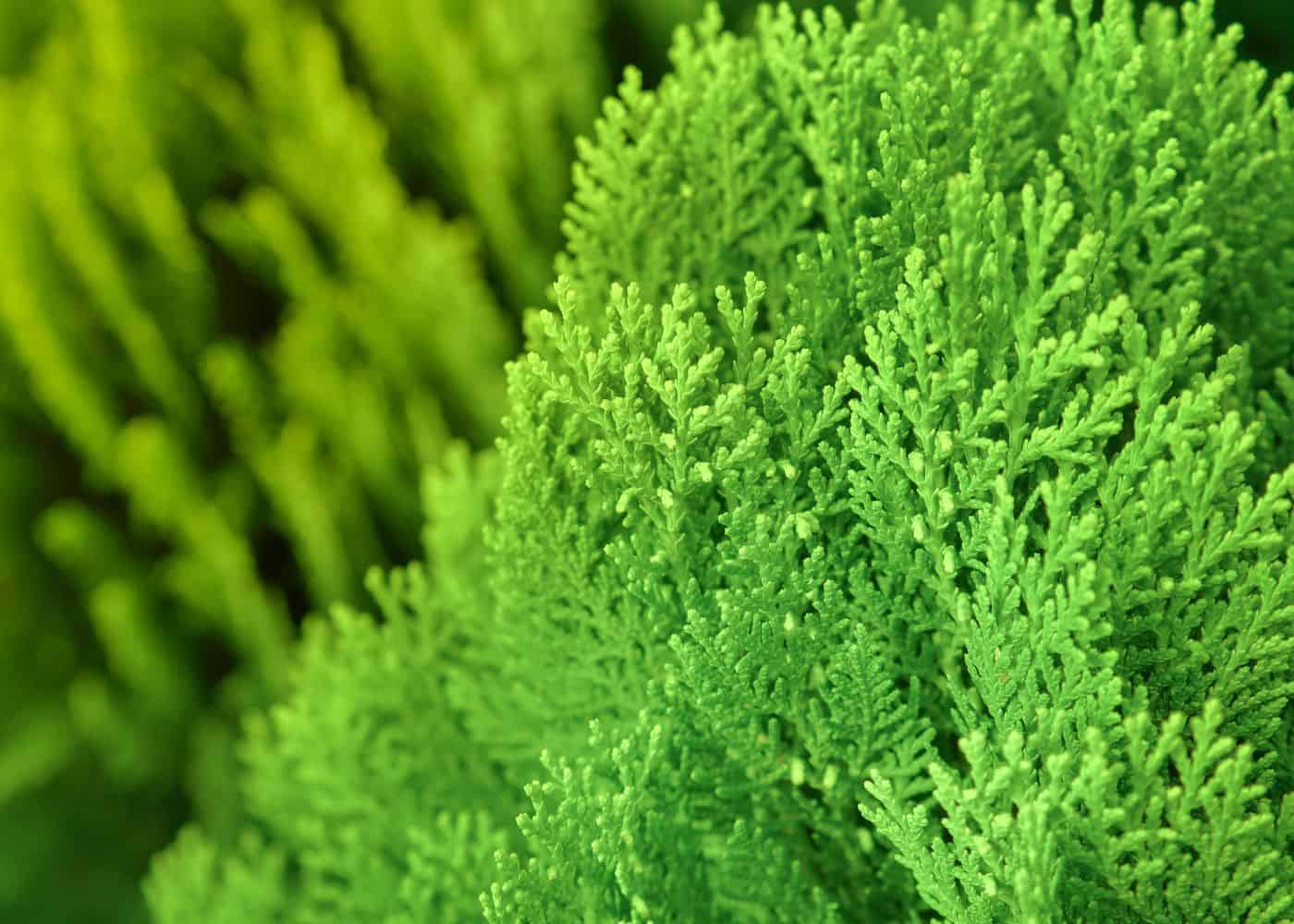
3. Hinoki cypress
Hinoki cypress (Chamaecyparis obtusa) is an evergreen species that offers several smaller cultivars. These compact cultivars make wonderful foundation plants:
- ‘Night Light’ Hinoki cypress (matures to 4-5 feet tall, 4-5 feet wide)
- ‘Koster’s’ Hinoki cypress (matures to 4-5 feet tall, 4-5 feet wide)
- ‘Tempelhof’ Hinoki cypress (matures to 8-10 feet tall, 4-6 feet wide)
Hinoki cypress, also called false cypress, are native to Japan. They tend to grow best in Zones 5-8.
4. Sky Pencil holly
Sky Pencil holly (Ilex crenata ‘Sky Pencil’) is a slow-growing narrow, evergreen shrub. These skinny plants grow naturally in a columnar with minimal pruning. They reach a mature size of 6-8 feet tall and 1-2 feet wide.
Sky Pencil Holly is most commonly used as a hedge plant to create a low screen. You can plant them along a path to define the walkway or around a patio. They can also be used to screen an unsightly fence or even your recycling bins. A single specimen is also useful as a tall accent in smaller gardens.
Sky Pencil Holly grows best in full sun but is tolerant of partial shade. These manageable shrubs are also well-suited to container planting. This cultivar is a female variety and will produce berries if grown nearby to a male cultivar.
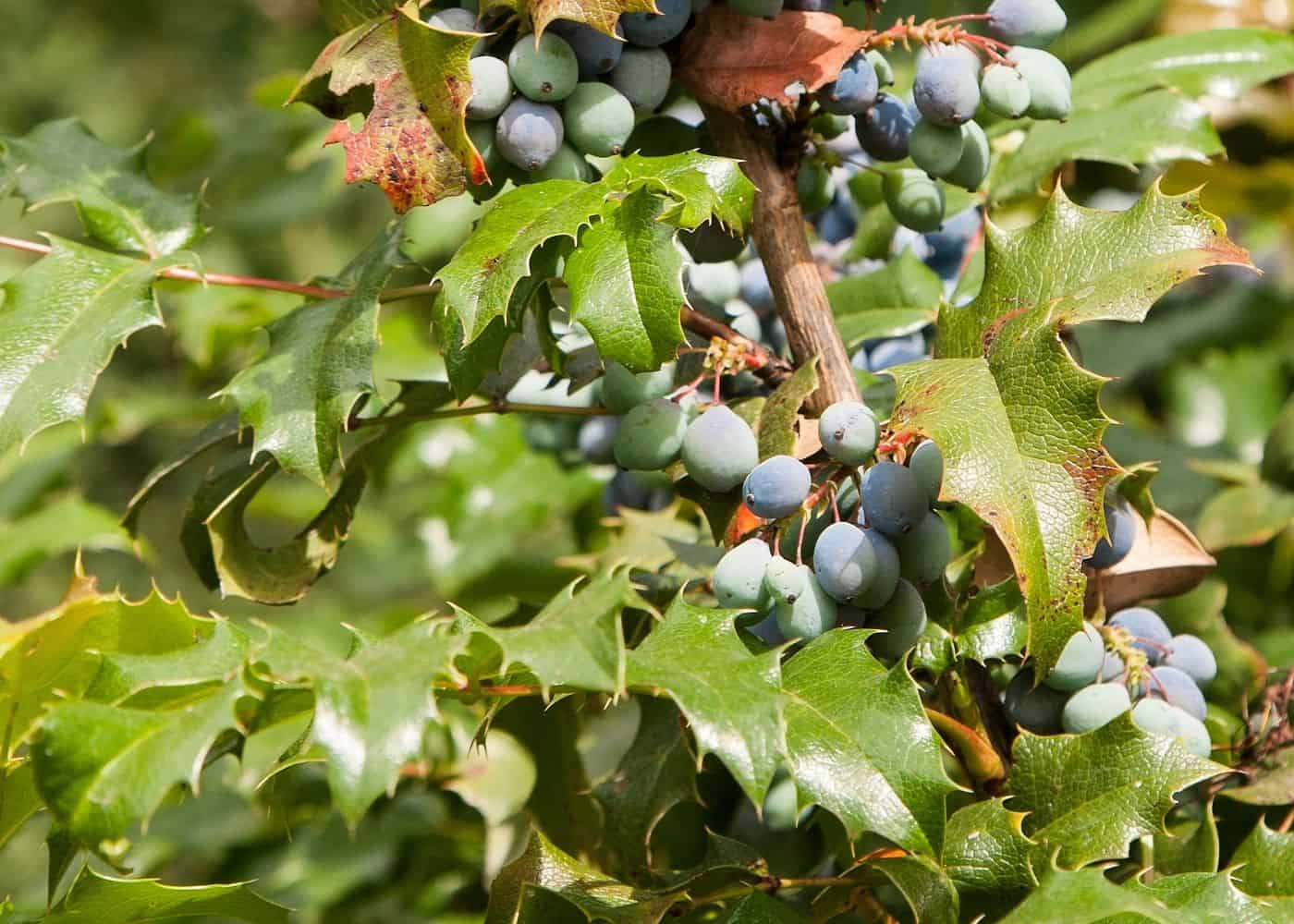
5. Oregon Grape Holly
Oregon Grape Holly (Berberis aquifolium, syn. Mahonia aquifolium) is a native broadleaf evergreen shrub. This plant is known for its bronzed-red green leaves, bright yellow flowers, and edible berries. Oregon Grape plants reach a mature size of about 3-5 feet tall and 4-6 feet wide.
Oregon Grape is used mainly as a low-maintenance natural landscaping plant in wildlife-friendly areas. This early bloomer attracts beneficial pollinators in the springtime and birds as the berries ripen in summer and into the fall. The sharp leaves also make this plant deer resistant.
Oregon Grape Holly grows best in full sun, but can be grown in partial shade or even in full shade (although it tends to grow quite thinly in the shade). This small evergreen grows best in Zones 5-9.
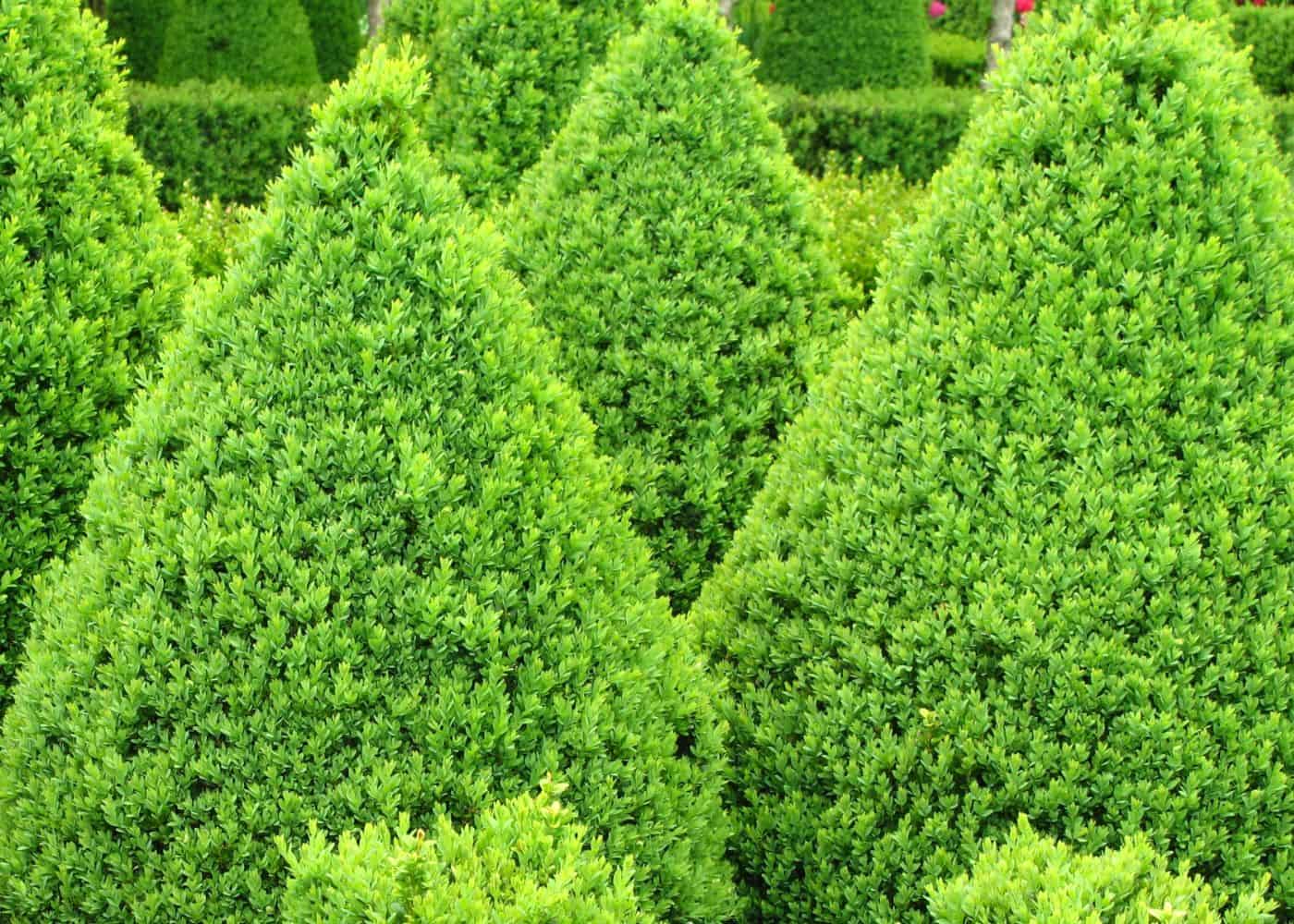
6. Green Mountain Boxwood
Green Mountain Boxwood (Buxus x ‘Green Mountain’) is a small cone-shaped broadleaf evergreen shrub. These beautiful plants grow to a mature size of 3-5 feet tall and 2-3 feet wide.
Due to its pyramidal form, ‘Green Mountain’ is most commonly used as an accent plant. Consider planting it towards the back of a perennial garden bed or placing it at the end of a low hedge.
Green Mountain Boxwood grows best in full sun, but is tolerant of partial shade. These plants grow best in Zones 5-8.
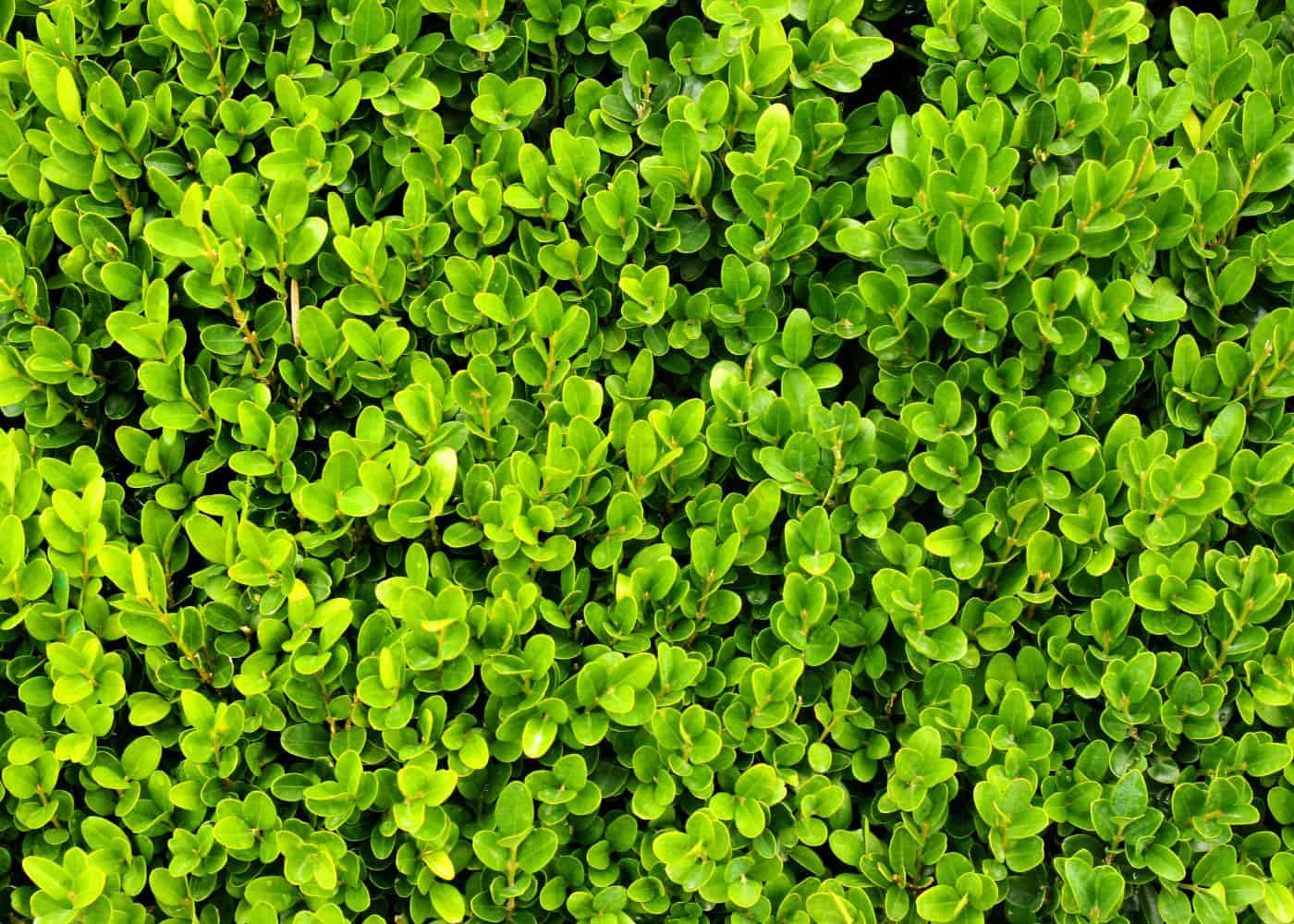
7. Green Velvet Boxwood
Green Velvet Boxwood (Buxus x ‘Green Velvet’) is a spreading broadleaf evergreen. These rounded shrubs typically reach a mature size of 3-4 feet tall and 3-4 feet wide.
This hybrid boxwood variety naturally grows into a rounded sphere shape. You can let the plant fill out naturally or shear it into a tight ball for a more formal look. Individual plants can be planted alone or in groupings (geometric or more organic). Green Velvet Boxwood are also quite commonly used to create a mid-height formal boxwood hedge (usually about 3 feet tall).
Green Velvet Boxwood grows best in full sun but is tolerant of partial shade. This shrub grows best in Zones 5-9 and is resistant to winter bronzing at the cooler end of this range.
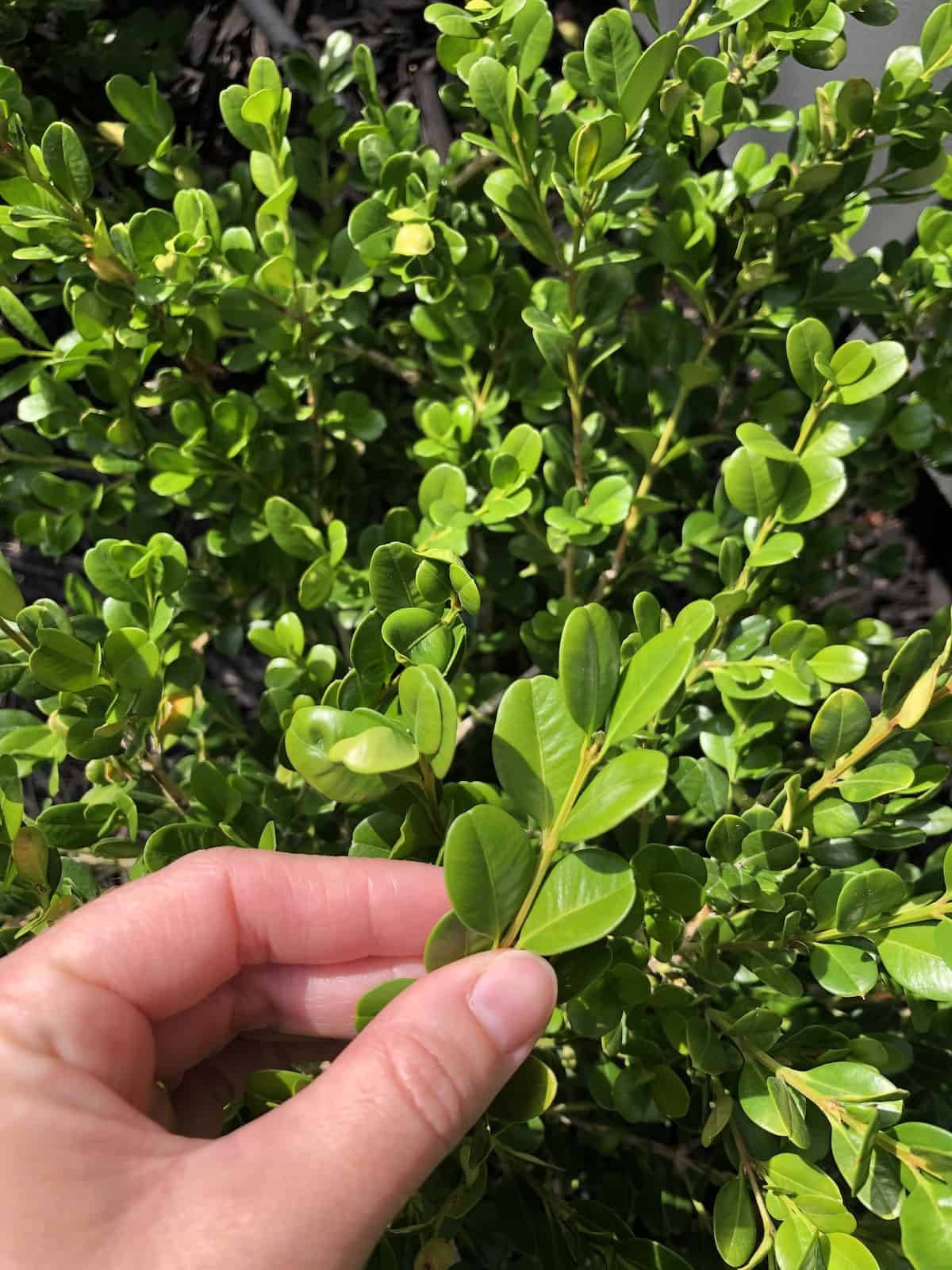
8. Winter Gem Boxwood
Winter Gem Boxwood (Buxus microphylla japonica ‘Winter Gem’) is a classic small evergreen shrub. Popular in both traditional and modern garden design, these plants grow to a petite mature size of 2-4 feet tall and 1-3 feet wide.
‘Winter Gem’ is most commonly used as a low hedging plant or low-growing foundation plant. The plants can be left unpruned for informal designs or can be sheared into a straight hedge for a formal appearance. These boxwoods can also be planted in containers.
Winter Gem Boxwood grows best in full sun, but is tolerant of partial shade. These plants thrive in Zones 5-9.
9. Green Gem Boxwood
Green Gem Boxwood (Buxus x ‘Green Gem’) is a classic small evergreen for formal gardens. These plants grow naturally into a compact ball shape, reaching a mature size of only 2-3 feet tall and 2-3 feet wide.
‘Green Gem’ plants are most commonly used as formal foundation plants, low hedge plants, or edging plants. They can be left unpruned to grow naturally or trimmed into a formal sheared shape.
Green Gem Boxwood grows best in full sun, but is tolerant of partial shade. These plants are also very cold-hardy, and thrive in Zones 4-9.
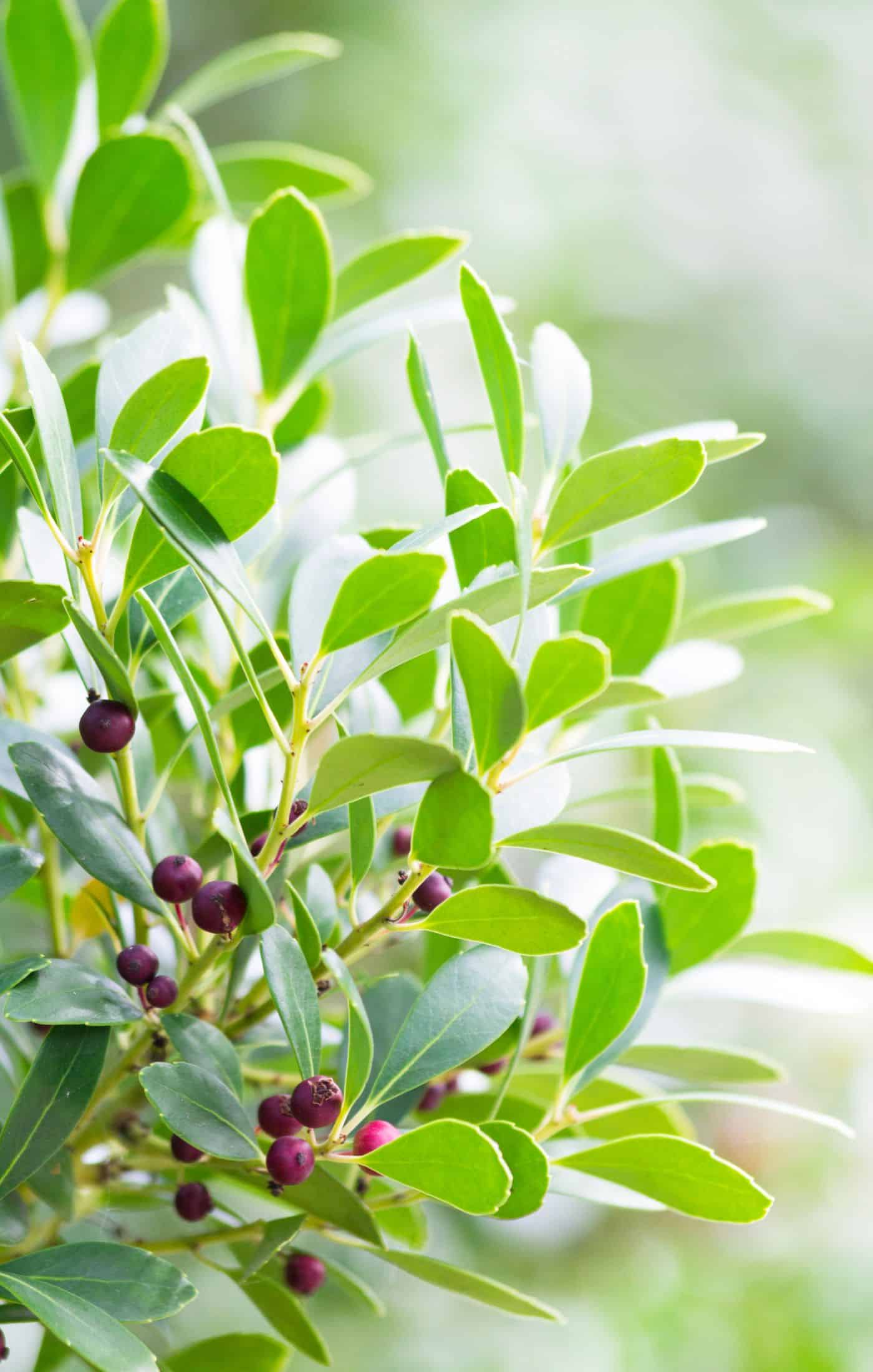
10. Gem Box Inkberry Holly
Gem Box Inkberry Holly (Ilex glabra ‘Gem Box’) is a specialty cultivar of low-growing native holly. These dwarf evergreens naturally grow into a ball-like shape, reaching a mature size of 2-3 feet tall and 2-3 feet wide.
‘Gem Box’ native holly is a great choice for both traditional and modern designs, particularly if there is an emphasis on planting native species. They can be used in a row as low hedge or garden bed edging plants, or planted individually as single specimens.
Gem Box Inkberry Holly grows best in full sun, but is tolerant of partial shade. These slow-growing plants thrive in Zones 5-9.
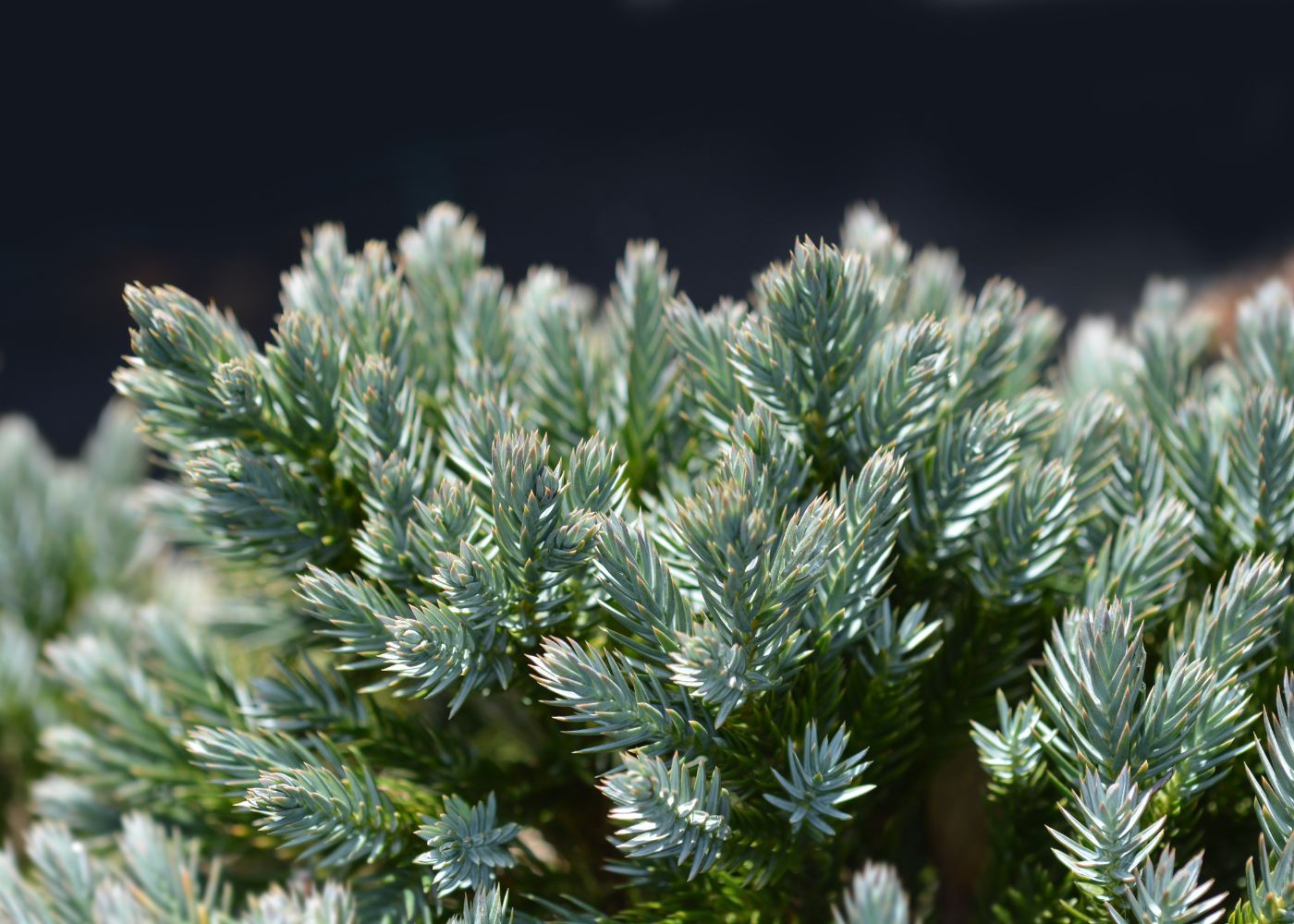
11. Blue Star Juniper
Blue Star Juniper (Juniperus squamata ‘Blue Star’) is a very small cultivar of needled evergreen. These plants are mounded and symettrical, reaching a mature size of 2-3 feet tall and 3-4 feet wide.
‘Blue Star’ is most commonly used as a foundation planting. It can also be used as a ground cover plant in larger spaces and on gently sloping hills. The silvery-blue foliage color makes this plant a wonderful choice for adding texture and tone to your garden design.
Blue Star Juniper should be planted in full sun for the best results, as juniper is not particularly tolerant of shade. These slow-growing plants thrive in Zones 4-8.
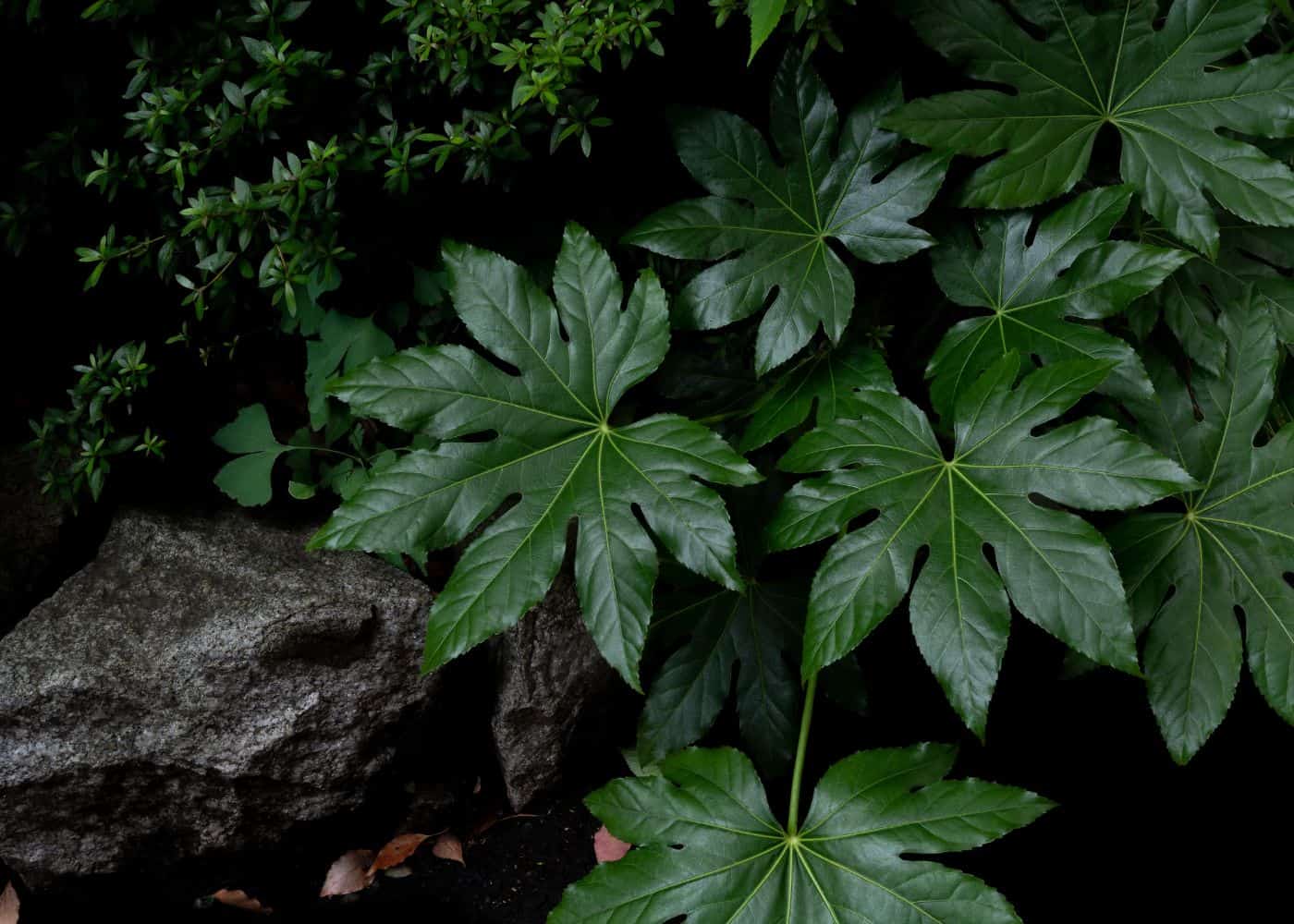
12. Japanese Aralia
Japanese Aralia (Fatsia japonica) is a rounded broadleaf evergreen shrub for warm climates that’s known for its large, exotic leaves and ornamental black berries. These plants grow at a moderate rate to reach a mature size of 5-8 feet tall and 5-8 feet wide.
Fatsia japonica is very versatile in the landscape. It can be used as a foundation plant, a privacy screen at the back of a perennial garden bed, or alongside a patio or pool. This evergreen flowering shrub blooms in late winter with delicate white flowers. In cool climates, Japanese Aralia can be planted in a container and moved indoors when there is threat of frost.
Japanese Aralia should not be planted in full sun, and should instead be sited in partial sun (at most). This plant is also tolerant of partial shade and even full shade. Japanese Aralia is a warm-climate plant, and thrives in Zones 8-11.
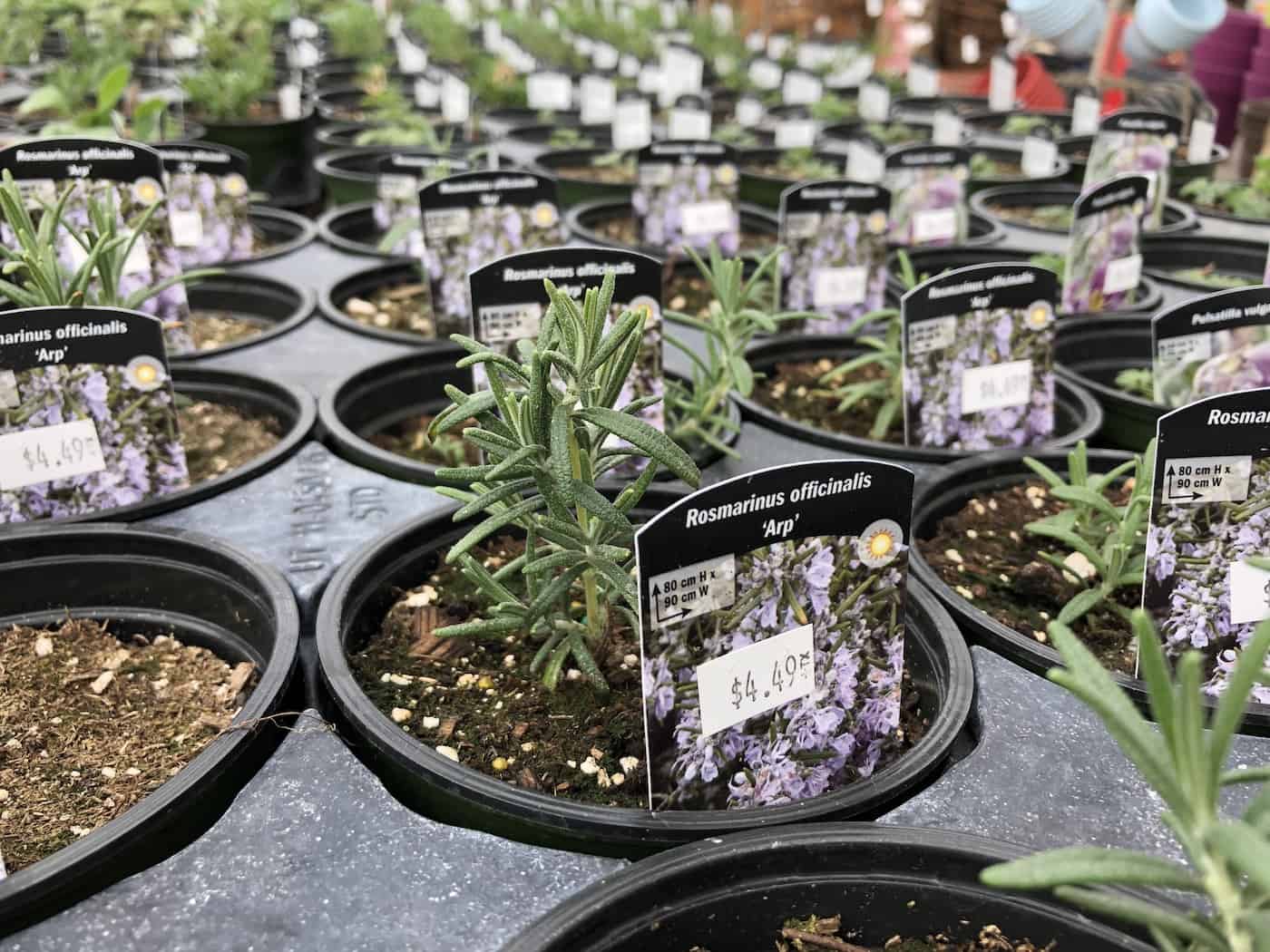
13. Arp Rosemary
Arp Rosemary (Rosmarinus officinalis ‘Arp’) is a small broadleaf evergreen shrub with both landscaping and culinary appeal. These classic plants grow to a mature size of 3-5 feet tall and 2-4 feet wide.
‘Arp’ is known as a cold-hardy rosemary cultivar for landscaping. While chefs prefer specific cultivars, such as ‘Tuscan Blue’, this variety is also wonderful for cooking with and for adding to fragrant bouqets and potporries.
Arp Rosemary is best planted in full sun. The plant may become weak and thin and may not flower well if planted in partial shade. Arp Rosemary can be grown in Zones 6-10, but is susceptible to winter damage at the cooler end of this range. Winter damage may consist of dead stem tips, leaf drop, or even the death of the entire aboveground portion in a particularly cold year.
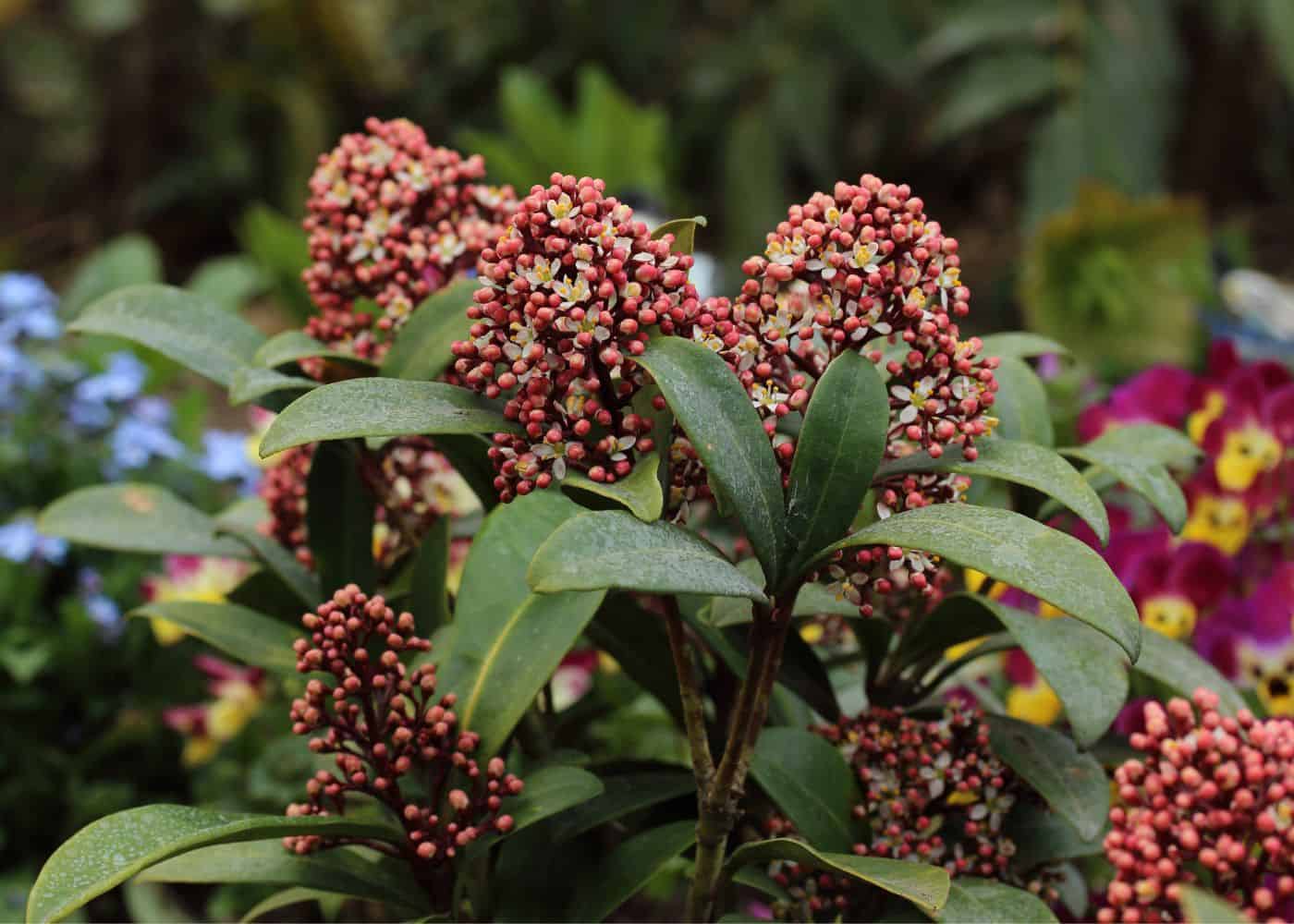
14. Japanese Skimmia
Japanese Skimmia (Skimmia japonica) is a slow-growing broadleaf flowering evergreen shrub. These mounded plants eventually reach a mature size of 2-5 feet tall and 3-6 feet wide.
This plant has many landscape uses, from a low hedge to a container plant. If both a female and male plant are paired, the cream-white flowers turn into festive bright red berries by late summer. These are not plants that like dry soil, however, so be sure to plant them somewhere that the soil can be kept consistently moist.
Japanese Skimmia should not be planted in full sun, and should instead be sited in partial sun (at most). This plant is quite tolerant of partial shade and even full shade, and is a great choice for a small flowering shrub in a shade garden. Japanese Skimmia thrives in Zones 7-9.
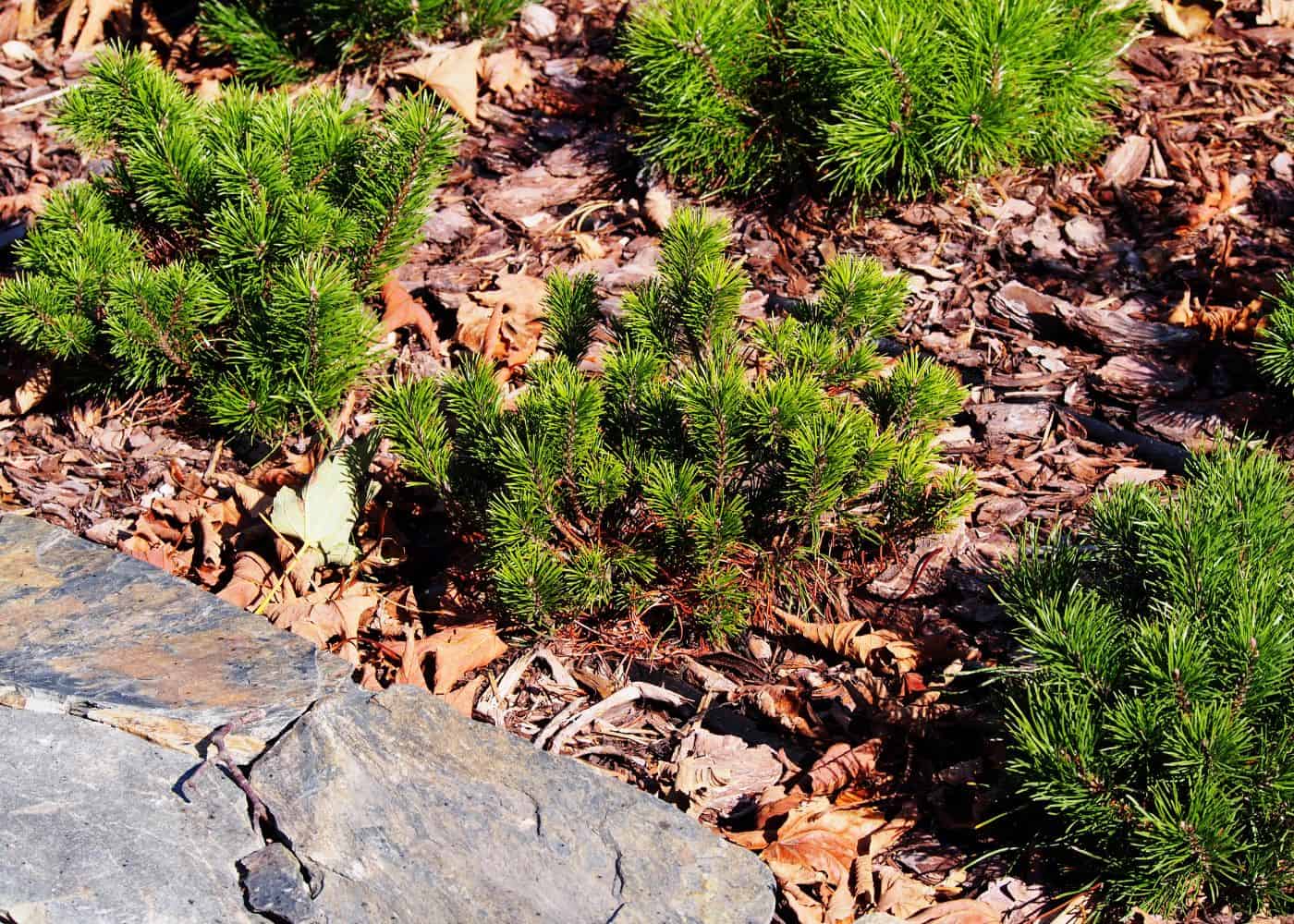
15. Dwarf Mugo Pine
Dwarf Mugo Pine (Pinus mugo var. pumilio) is a popular slow-growing dwarf conifer. These tiny needled evergreens have a dense habit and grow to a mature size of 3-5 feet tall and 3-5 feet wide.
Mugo Pine is a popular specimen plant for front yards and garden beds where sight lines must be maintained. The plants are generally planted alone, but can also be grouped organically in larger spaces.
Dwarf Mugo Pine grows best in full sun. This cold-hardy species thrives in Zones 2-8.
16. Sea Green Juniper
Sea Green Juniper (Juniperus x pfitzeriana ‘Sea Green’) is a relatively new juniper cultivar known for its free-form habit with gracefully arching branches. This variety grows to a mature size of 4-6 feet tall and 6-8 feet wide.
This variety is most commonly planted in a group, as either an informal hedge or as a staggered grouped planting. ‘Sea Green’ would do well along a driveway or fenceline. They are commonly used as a backdrop in a large garden bed as they pair nicely with ornamental grasses, flowering shrubs, and herbaceous perennials.
Sea Green Juniper grows best when planted in full sun. These plants can be grown in Zones 4-9.
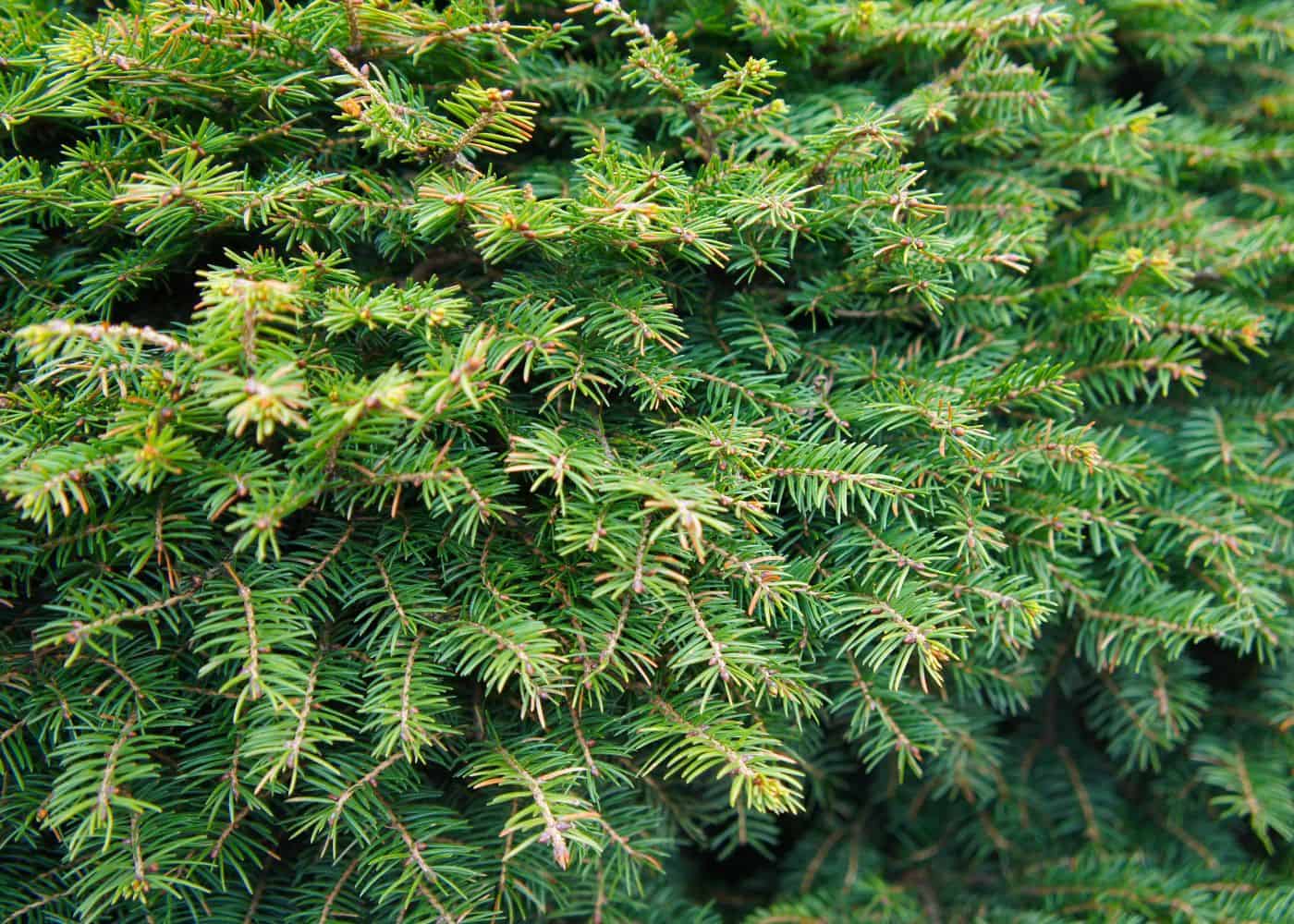
17. Bird’s Nest Spruce
Bird’s Nest Spruce (Picea abies ‘Nidiformis’) is a specialty cultivar of Norway Spruce known for its low-growing spreading growth habit. Mature plants typically reach a mature size of about 3 feet tall and 4-5 feet wide.
These plants are used almost exclusively as feature plants due to their unique form. As the name suggests, the plants are bowl-shaped, with the outside perimeter of the foliage growing taller than the foliage in the center of the plant.
Bird’s Nest Spruce should be planted in full sun for best results. This plant thrives in Zones 3-7.
18. Blue Pacific Juniper
Blue Pacific Juniper (Juniperus conferta ‘Blue Pacific’) is a juniper variety that is so short, it’s most commonly used as a groundcover. These interesting plants grow to a mature size of only about 1 foot tall, but spread out to about 6 feet wide.
Like other junipers, ‘Blue Pacific’ grows best in full sun. This type of juniper is not as cold-hardy as some others, and thrives in Zones 5-9.
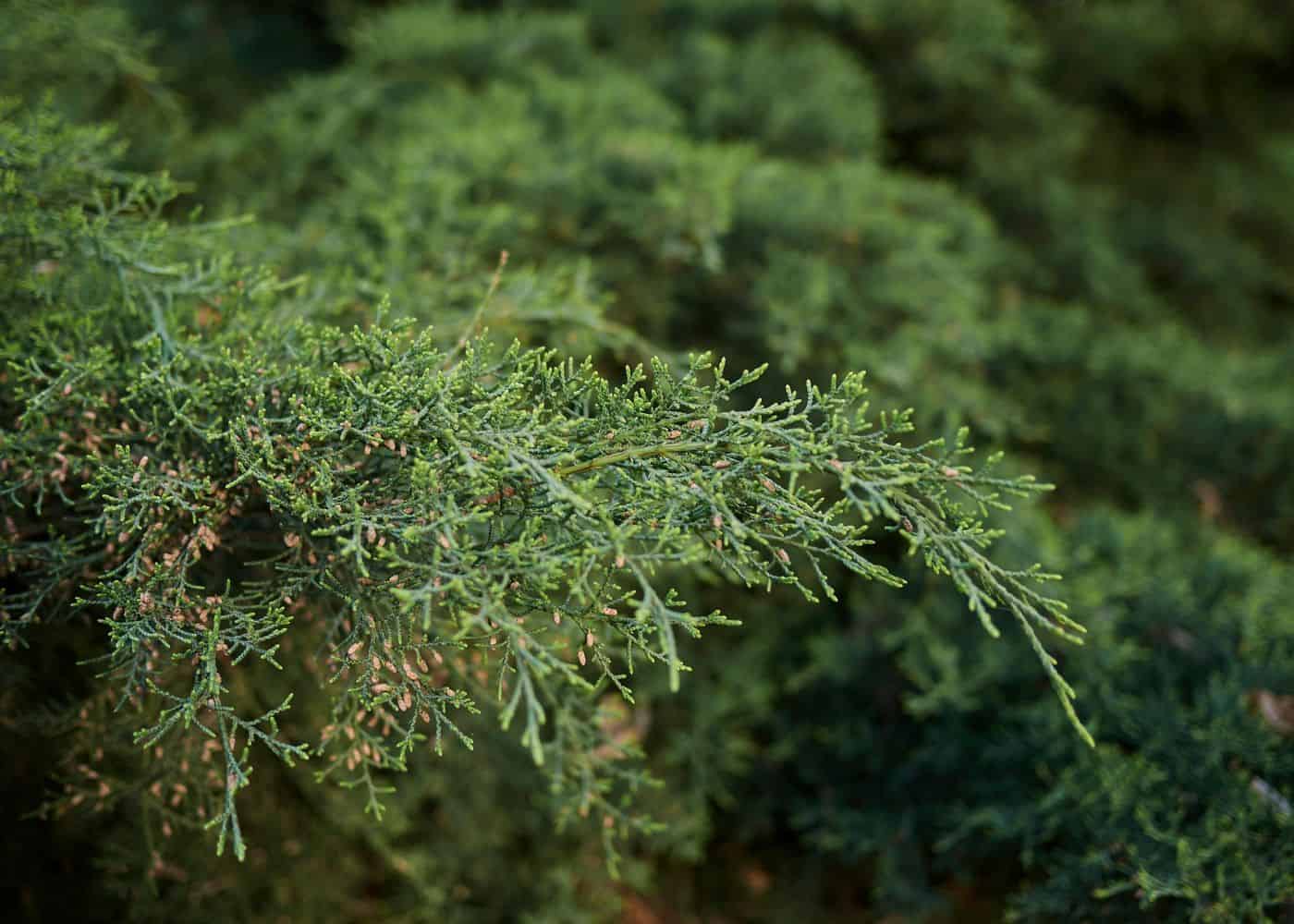
19. Grey Owl Juniper
Grey Owl Juniper (Juniperus virginiana ‘Grey Owl’) is a dwarf needled evergreen cultivar. Mature plants are about twice as wide as they are tall, and grow to a size of 2-3 feet tall and 5-6 feet wide.
Grey Owl Juniper grows best in full sun. This plant thrives in Zones 4-9.
20. Soft Caress Mahonia
Soft Caress Mahonia (Mahonia eurybracteata ‘Soft Caress’) is a dwarf mahonia variety with a compact growth habit. This yellow- flowering plant grows to a mature size of 3-4 feet tall and 3-4 feet wide.
This plant works well as either a featured accent plant or in a low mass planting in a larger space. Unlike most types of Mahonia, this variety is named for its softer leaves (making it more appropriate for beside walkways than the sharp-leaved varieties).
Mahonia grows best in partial sun to partial shade. While tolerant of full shade, the plant likely will not flower well with little available sunlight for photosynthesis. This plant thrives in Zones 7-9.
21. Manhattan Euonymus
Manhattan Euonymus (Euonymus kiautschovicus ‘Manhattan’) is a fast-growing broadleaf evergreen shrub. These vigorous plants look a bit like giant boxwoods, and reach a mature size of 6-8 feet tall and 4-6 feet wide.
Euonymus shrubs make wonderful informal hedges, and can be used on their own or as a backdrop plant for a garden bed. They can also be trimmed into a more formal look or trellised along a wall.
Manhattan Euonymus grows best in full sun but is quite tolerant of shade. While the plant won’t grow as vigorously in full shade as it would in full sun, it still manages to put on quite a bit of growth each year. This plant thrives in Zones 5-8.
22. Eternal Fragrance Daphne
Eternal Fragrance Daphne (Daphne x transatlantica ‘Eternal Fragrance’) is a broadleaved evergreen flowering shrub known for its beautiful scent. This compact variety grows to a mature size of 2-3 feet tall and 2-3 feet wide.
The floral scent of this plant makes it a good choice for along a walkway or next to an entryway. Place them around a patio or deck, where they can be fully enjoyed. They can also be massed along a gentle slope.
Daphne flowers best in full sun, but is tolerant of partial shade. This plant thrives in Zones 6-9.
23. Little Gem Norway Spruce
Little Gem Norway Spruce (Picea abies ‘Little Gem’) is a tidy, low-growing evergreen shrub. This needled evergreen grows to a mature size of only 1-2 feet tall and about 3 feet wide.
‘Little Gem’ is frequently used as a foundation plant in front of smaller buildings and as a specimen plant in featured garden beds. They grow quite slowly and won’t outgrow their space, requiring minimal maintenance.
Little Gem Norway Spruce grows best in full sun. These shrubs are particularly cold-hardy, and can be grown in Zones 2-8.
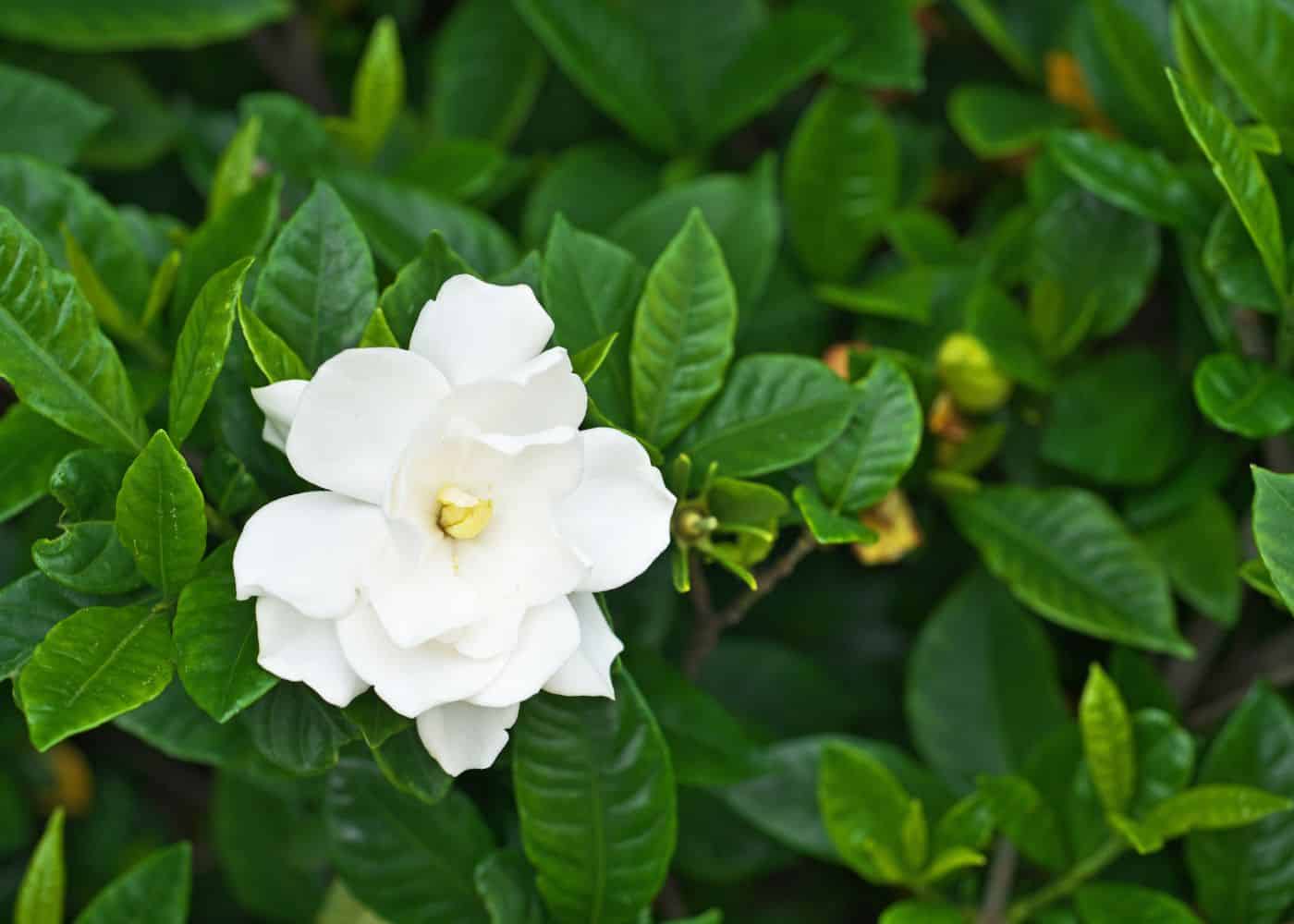
24. August Beauty Gardenia
August Beauty Gardenia Shrub (Gardenia jasminoides ‘August Beauty’) is a small flowering evergreen shrub. Suitable only for warm climates, this plant grows to a mature size of 4-6 feet tall and 3-4 feet wide.
‘August Beauty’ is the perfect plant for beside entryways, gates, and doors. It also is a perfect bush for adding to cozy courtyard settings where its beautiful scent can be enjoyed.
August Beauty Gardenia flowers best when planted in full sun. This warm-climate plant thrives in Zones 8-11, and is only cold-hardy down to about 20℉ (-7°C).
25. Emerald Gaiety Euonymus
Emerald Gaiety Euonymus (Euonymus fortunei ‘Emerald Gaiety’) is a broadleaf evergreen known for its variegated leaves. This low-growing mounded plant reaches a mature size of 2-4 feet tall and 3-4 feet wide.
‘Emerald Gaiety’ is often used as a foundation planting alongside a building or as a year-round interest plant in a perennial garden bed. These low-maintenance plants can also be planted en masse over a gently sloping area to cut down on mowing requirements.
Emerald Gaiety Euonymus grows best in full sun but is tolerant of partial shade and even of full shade (although the variegation likely won’t be as striking). These plants thrive in Zones 5-9.
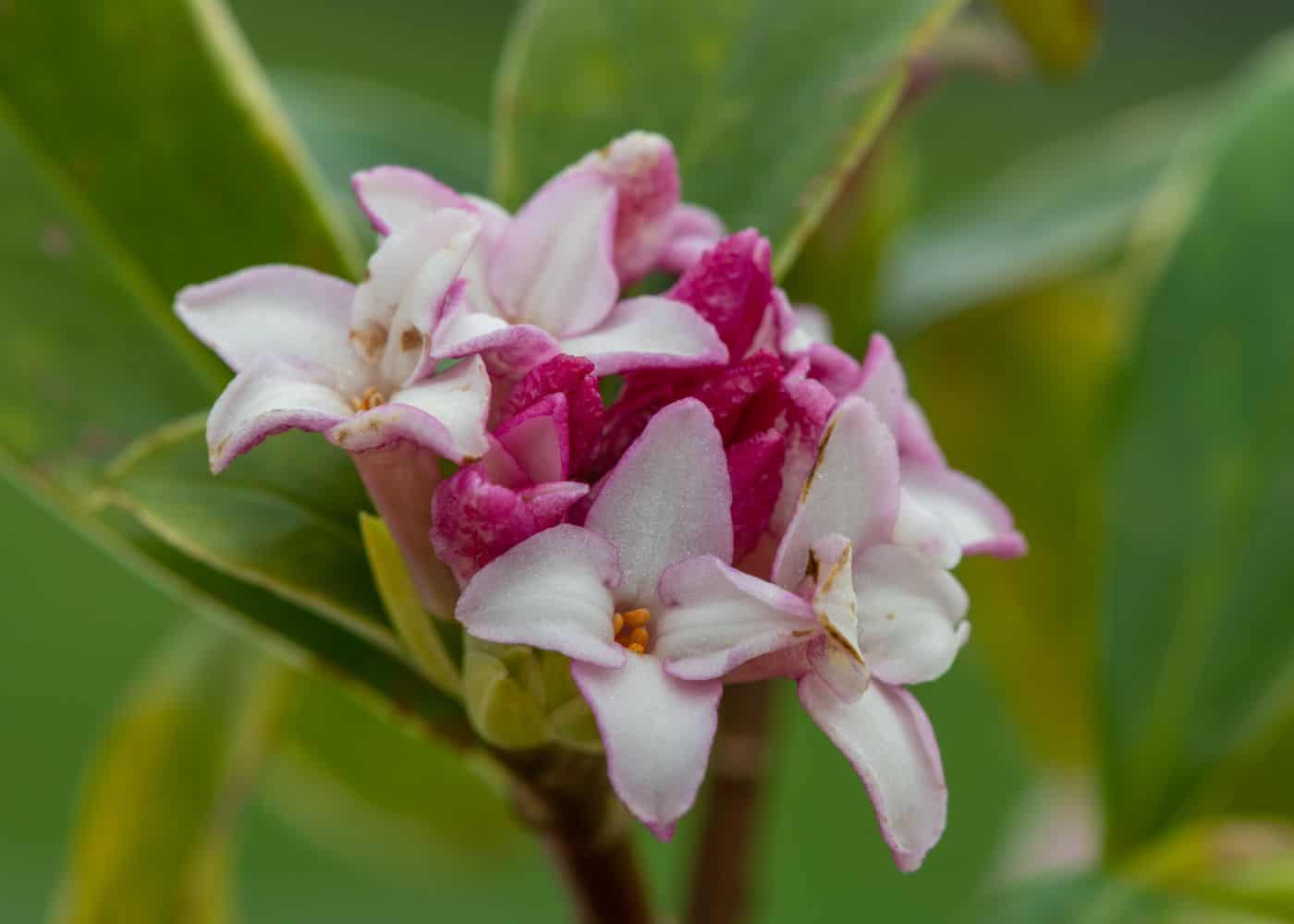
26. Perfume Princess Daphne
Perfume Princess Daphne (Daphne x ‘Perfume Princess’) is a flowering evergreen shrub known for its highly-scented and long-lasting flowers. This plant grows to a mature size of about 4 feet tall and 3 feet wide.
Daphne is best planted where it can be enjoyed. This variety blooms particularly early and for a particularly long time. It works well as a foundation planting (especially under a working window, where its fragrance can be enjoyed indoors and out). It’s also perfect beside a driveway, pathway, or entrace.
Daphne flowers best in full sun as long as the plant receives enough water. This cultivar is particularly tolerant of sunlight and heat in warmer climates, and is a good choice for a sunny spot. These shrubs are also tolerant of partial shade, and while they may not flower as much in the shade, they won’t require watering as frequently and may benefit from afternoon shade in the hottest climates. Perfume Princess Daphne can be grown in Zones 7-9.
FAQs
What are the best dwarf evergreen shrubs under 2 feet tall?
Here are some of the best dwarf evergreens that either grow naturally to a height less than 2 feet tall, or can easily be kept under 2′ for borders with some pruning.
Green Gem Boxwood (Buxus x ‘Green Gem’): 2-3 feet tall and 2-3 feet wideGem Box Inkberry Holly (Ilex glabra ‘Gem Box’): 2-3 feet tall and 2-3 feet wide
Blue Pacific Juniper (Juniperus conferta ‘Blue Pacific’): 1 foot tall and 6 feet wide
Grey Owl Juniper (Juniperus virginiana ‘Grey Owl’): 2-3 feet tall and 5-6 feet wide
Dwarf Radicans Gardenia (Gardenia jasminoides ‘Radicans’): 1-2 feet tall and 3-4 feet wide
Eternal Fragrance Daphne (Daphne ‘Eternal Fragrance’): 2-3 feet tall and 2-3 feet wide
Little Gem Norway Spruce (Picea abies ‘Little Gem’): 1-2 feet tall and 3 feet wide
What are the best small evergreen shrubs for full sun?
Sunshine Ligustrum (Ligustrum sinense ‘Sunshine’)
Blue Star Juniper (Juniperus squamata ‘Blue Star’)
Dwarf Alberta Spruce (Picea glauca ‘Conica’)
Green Velvet Boxwood (Buxus x ‘Green Velvet’)
Arp Rosemary (Rosmarinus officinalis ‘Arp’)
Bird’s Nest Spruce (Picea abies ‘Nidiformis’)
What are the best small evergreen shrubs for shade?
Japanese Skimmia (Skimmia japonica)
Soft Caress Mahonia (Mahonia eurybracteata ‘Soft Caress’)
Japanese Aralia (Fatsia japonica)
Eternal Fragrance Daphne (Daphne x transatlantica ‘Eternal Fragrance’)
Resources
- Small evergreen shrubs
- Tall evergreen shrubs
- Low-maintenance evergreen shrubs
- Best evergreen shrubs for front of house
- Fast-growing evergreen shrubs
- Best evergreen shrubs for privacy
- Evergreen flowering shrubs
- Small evergreen flowering shrubs
References
- Colorado State University Extension, Evergreen Shrubs
- University of Missouri Extension, Selecting Landscape Plants: Broad-leaved Evergreens
- University of Minnesota Extension, Choosing evergreens for your landscapes
- PennState Extension, Evergreen Native Plants
More landscaping shrubs
Time to add some shrubs to your landscape to brighten things up year-round, provide privacy, and perhaps even some flowers?


